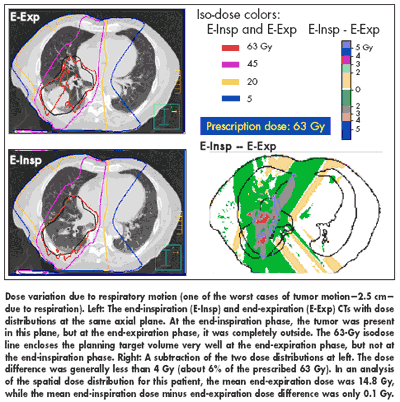Method helps standardize RT dose reporting
A new method for converting between different definitions of lung volume may help standardize radiation dose reporting for patients receiving radiation therapy for lung cancer, finds a study using four-dimensional CT imaging. 4D-CT is a series of CT scans that measure how much a tumor moves when a patient breathes and allows radiation oncologists to personalize radiation treatment for this motion.
LOS ANGELES-A new method for converting between different definitions of lung volume may help standardize radiation dose reporting for patients receiving radiation therapy for lung cancer, finds a study using four-dimensional CT imaging. 4D-CT is a series of CT scans that measure how much a tumor moves when a patient breathes and allows radiation oncologists to personalize radiation treatment for this motion.

“ 4D-CT has gradually moved into routine clinical practice. To apply our past clinical experience with fast-spiral free-breathing CT to the new practice using 4D-CT, we need to address a few concerns,” lead author Yixiu Kang, PhD, said at an ASTRO 2007 plenary session (abstract 2).
Radiation doses are measured by the volume of a person’s lungs, and lung volumes change during each phase of the breathing cycle. “We need to know the relationships between lung volumes and between the dose-volume parameters defined on different CT images, and how to standardize the dose-volume reporting,” Dr. Kang said.
The retrospective study included 40 patients with stage III-IV non-small-cell lung cancer who were prescribed a radiation dose of 45 to 70 Gy and underwent both a fast free-breathing helical CT and a 4D-CT, said Dr. Kang, a research scientist at The University of Texas M.D. Anderson Cancer Center.
Each 4D-CT was partitioned into 10 equal respiratory phases from 0% to 90%. End-inspiration phase was defined as the 0% phase; end-expiration phase, the 50% phase; and average, the average of a given voxel’s values over all 10 phases. Dose distributions were calculated for the different phases.
On average, compared with the end-expiration lung volume, the end-inspiration lung volume was about 14% greater, the average lung volume was about 9% greater, and the free-breathing lung volume was about 6% greater, Dr. Kang said. As a result of respiration, the tumor moved considerably in some patients, but the dose difference was generally small (see Figure).
Dose analysis
In a dose analysis conducted among 20 of the patients, the mean dose was 15.1 Gy at end expiration, and the mean dose difference, compared with end expiration, was 0.12 Gy for end inspiration, 0.05 Gy for average, and 0.06 Gy for free breathing, which were nonsignificant differences, Dr. Kang said.
Analyses of the lung volume receiving more than 20 Gy (V20) at various phases showed that the end-expiration V20 could be multiplied by 0.973 to obtain the free-breathing V20, by 0.970 to obtain the average V20, and by 0.945 to obtain the end-inspiration V20. Results were similar for the lung V5 and the lung V50.
“In general, the end-expiration CT had the worst-case DVH [dose-volume histogram] value, the end-inspiration CT had the best-case DVH value, and the averaged and free-breathing CT had DVH values between the end-expiration and end-inspiration values,” she said.

Taken together, Dr. Kang said, the results suggest that lung volume changes (as opposed to dose distribution changes) account for most of the observed variation in lung dose-volume parameters.
“The lung dose-volume parameters can be converted between different volume definitions by using conversion factors,” she said. “At M.D. Anderson, we have chosen to define the lung volume on the end-expiration CT, since it was the most conservative and most consistent phase for DVH evaluation and had minimal 4D-CT imaging artifacts.”

Stephen M. Hahn, MD, chairman of radiation oncology at the University of Pennsylvania, commented on the study: “Dr. Kang and colleagues demonstrated the importance of assessing lung volumes for radiotherapy planning. They showed the difficulties in assessing the target in lung because of respiratory motion. Much research such as this is needed to improve the treatment planning for lung radiotherapy.”